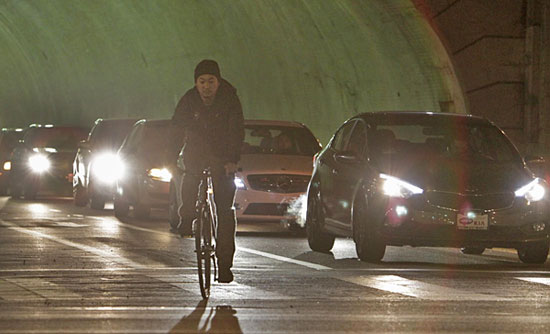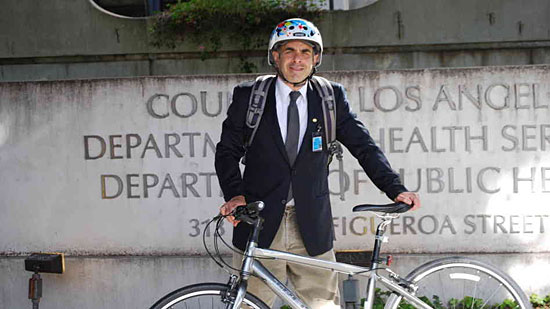Bike boom’s hidden headache
May 15, 2014
There’s good news on the cycling front, with a new report showing L.A. bike use growing by 7.5% and new lanes, paths and “sharrows” buzzing with two-wheeling commuters and recreational cyclists.
But there’s also a less heralded statistic in the 2013 Bike and Ped Count released this week by the Los Angeles County Bicycle Coalition:
Only 46% of L.A. cyclists wear helmets.
That’s troubling to medical experts like Dr. Mitchell Katz, director of the county’s Department of Health Services and a (helmet-wearing) cyclist in his own right.
“The evidence from a medical point of view is very clear: helmets prevent brain injury, and brain injuries are some of the most devastating events besides the possibility that you might actually die,” Katz said.
Katz said his own experiences on the streets of L.A. corroborate the report’s findings on helmet-wearing.
“I’ve noticed that certainly more than half of the bicyclists do not. I think young people are especially guilty of not wearing helmets,” Katz said.
Those riders are taking a big chance, given that 15- to 19-year-olds were the bicyclists likeliest to land in L.A. County emergency rooms in 2012, with 64.3 per 100,000 people in that population showing up to be treated for bike injuries.
Injuries to Los Angeles County cyclists are steadily increasing, from 2,916 hurt in collisions with vehicles in 2007 to 4,759 injured in 2011, according to state data provided by the county Department of Public Health. Twenty-six bike riders were killed in 2007 and 30 in 2011. Only 14% of those injured and just 20% of those killed were using “safety equipment” at the time of their accidents in 2011.
However, the state injury data did not include a specific breakout for helmet usage within the category of “safety equipment”—something Katz said could be helpful in raising consciousness about the dangers of riding without protective headgear.
“I think there is a misconception, that people think, ‘I’m a great bicycle rider. I don’t need to wear a helmet.’ What they’re not thinking of is it doesn’t have anything to do with what kind of bicycle rider I am. It has to do with whether a car hits me and I fly through the air. You don’t have any control, once you’re flying through the air, of how you land,” Katz said.
Adults aren’t legally required to wear bike helmets in California, but advocacy groups like the Bicycle Coalition officially recommend them. And when elected officials like Los Angeles Mayor Eric Garcetti go out for a spin on Bike to Work day, they’re invariably photographed wearing a helmet.
So why aren’t more L.A. cyclists following their lead?
The answer is complicated—and, within the cycling community, often polarizing.
“It can get pretty heated once you start talking about helmet use because there’s a contingent of bicyclists who are really adamant about wearing helmets and there’s a contingent of bicyclists who are really adamant about not wearing a helmet,” said Colin Bogart, education director for the Bicycle Coalition, who advises his students to don helmets and always wears one himself.
Some people “just don’t think it’s that important…it’s the ‘it’s-not-gonna-happen-to-me’ sort of thing,” Bogart said. Then there are those sometimes called “invisible riders”—day laborers and other workers commuting by bike out of necessity and perhaps unable to afford safety equipment like helmets and lights.
And, particularly among younger riders, “there’s the whole coolness factor, right?” Bogart said. “It’s like, ‘You’re a dork if you wear a helmet.’ ”
Underlying the contentious issue is the feeling—held even by bike advocates who strongly recommend helmet use—that too much focus on headgear diverts attention from a broader mission of pushing for better, safer cycling spaces throughout the city.
“I think ultimately what we’d like to see is a situation in which our built environment is such that people don’t even feel like they need to have a helmet because they feel so safe doing it,” Bogart said. “When you look at photographs of people biking in a lot of these cities in the world where the percentage of cycling is way beyond anything we have here, almost nobody is wearing a helmet. [That’s] because it’s viewed as so everyday and so not hazardous to your safety that people just ride without ‘em. “
Although some, like Dr. Katz, think it would be a good idea to pass laws mandating helmet use for adult bicyclists as well as those 18 and under, Bogart said he believes that could deter would-be riders from joining the growing cycling movement.
“That’s a real concern, that if you make it a requirement, a lot of people are just going to say, OK, forget it,” Bogart said.
The helmet statistic was not highlighted in the bike count’s official news release. But it might dovetail with another finding: that fewer than 20% of L.A. cyclists are female. That suggests there still aren’t enough safe bikeways to attract women, traditionally considered more “risk-averse” riders.
To get more women, children and older people bicycling on city streets, the new report calls for creation of more “protected bikeways,” which carve out dedicated space for cyclists to ride with some separation from automobile traffic.
Because let’s face it: “If you’re riding on the streets as they are right now, you’re pretty risk tolerant,” said Eric Bruins, the coalition’s planning and policy director.
Posted 5/15/14














 405 bridge work causes a stink
405 bridge work causes a stink

